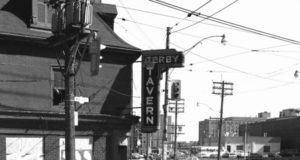Eric Morse –
As reported in the April edition of The Bulletin, a group of students from the Ryerson school of urban and regional planning has been working with the Corktown Residents’ and Business Association (CRBA) to develop a heritage study for the Corktown neighbourhood.
On April 11, the group presented its final recommendations to an audience of their peers and a review panel of Matt Elliott and Sandra Iskandar from CRBA’s board, Loren Acker from the city’s planning department, and Tom Davidson from councillor Pam McConnell’s office, plus project supervisor and professor Tom Ostler.
The project team came up with three principal recommendations: to update the King-Parliament secondary plan and community improvement plan, to identify individual buildings for heritage listing or designation (a list of potential buildings was provided), and to designate up to three heritage conservation districts, determined by their critical mass of heritage buildings. The districts nominated were Percy St./Ashby Place, Bright St., and the area bordered by Parliament St., Front St., Eastern Ave, Trinity St and King St. E.

The study also suggested—in parallel with a simultaneous Ryerson study of Corktown parks—that CRBA consider a project to memorialize the lost streets of Corktown, many fragmented or simply eradicated when the Adelaide-Richmond overpasses were built. One of the points made by the team was that it’s hard to determine how many heritage buildings actually exist in Corktown because many of the ground floor frontages have been resurfaced through the years with stucco or cladding and no one really knows what is beneath the present surface.
CRBA representative Sandra Iskandar expressed some concern that the massive redevelopment of the West Don Lands seemed to be excluding any opportunity for commemoration of the historic past of the area.
Projects like the Corktown study are undertaken by Ryerson with support from the city. They are intended as academic exercises for grading, but they also serve as rich inputs to the partnered neighbourhoods which would probably not be affordable as consultancies, and the city therefore takes a lively interest in their recommendations. When a member of the review panel asked which of the three identified areas the team would recommend as a priority, the answer was (rather deftly) returned that that would be an issue which Corktown residents themselves must decide.
CRBA secretary Matt Elliott commented afterward that he was most drawn to the idea of designating heritage districts, and said that the CRBA would be looking at all three potential candidates.
He acknowledged that Corktown faces a slightly odd issue in the possible application of Section 37 funds simply because the developments that might be sources for Section 37 funds are not actually in Corktown but on its periphery.
However he also noted that consultations with Heritage Toronto indicate that the designation of smaller heritage districts is potentially less onerous: “We’re hopeful that through creative ways we can make it work.”
 TheBulletin.ca Journal of Downtown Toronto
TheBulletin.ca Journal of Downtown Toronto


